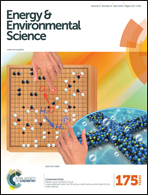The morphology-controlled synthesis of a nanoporous-antimony anode for high-performance sodium-ion batteries†
Abstract
We have presented a comprehensive study of using chemical dealloying methods to control the morphology of nanoporous-antimony (NP-Sb) and the size of Sb particles. For the first time, depending on the regulation of the Al–Sb alloy composition, coral-like NP-Sb (NP-Sb70), honeycomb-like NP-Sb (NP-Sb80) and Sb particles (Sb10, Sb30 and Sb45) with different sizes were prepared through chemical dealloying of Al30Sb70, Al20Sb80, Al90Sb10, Al70Sb30 and Al55Sb45 (at%) alloy ribbon precursors respectively, a top-down process. The NP-Sb70 delivered a high capacity of 573.8 mA h g−1 after 200 cycles at a rate of 100 mA g−1 with good rate capability as anode for sodium-ion batteries (SIBs). The excellent electrochemical performance is because of its innovative electrode design, which ensures strong structural integrity, high sodium ion accessibility, and fast electrode transport. This scalable strategy shall pave the way for the mass production of large-capacity electrodes for SIBs and other energy storage systems, providing new guidelines for the optimization of the synthesis of nanostructures.


 Please wait while we load your content...
Please wait while we load your content...